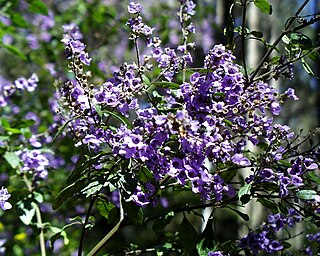
Prostanthera melissifolia, commonly known as balm mint bush, is a species of flowering plant in the family Lamiaceae and is endemic to south-eastern Australia. It is an erect shrub with hairy branches, egg-shaped leaves with fine teeth on the edges and mauve to purple or pink flowers on the ends of branchlets.

Prostanthera eurybioides, commonly known as Monarto mintbush, is a species of flowering plant in the family Lamiaceae and is endemic to the south-east of South Australia. It is a low, spreading shrub with densely hairy branches, thick, elliptic to egg-shaped leaves clustered on short shoots, and violet to mid-purple flowers that are white with orange and dark purple dots inside the petal tube.
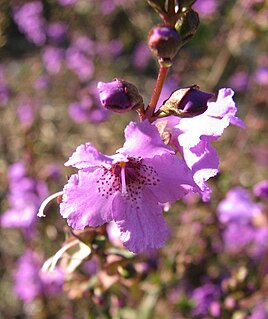
Prostanthera galbraithiae, commonly known as Wellington mint-bush, is a species of flowering plant in the family Lamiaceae and is endemic to Victoria in Australia. It is an erect or spreading shrub with densely hairy branches that are more or less square in cross-section, narrow egg-shaped or oblong leaves with the edges rolled under, and deep mauve to purple flowers with maroon dots inside the petal tube.

Prostanthera stenophylla is a species of flowering plant in the family Lamiaceae and is endemic to Wollemi National Park in New South Wales. It is an erect, slender, aromatic shrub with hairy, oblong leaves and small groups of pale bluish mauve to violet flowers.

Prostanthera marifolia, commonly known as Seaforth mintbush, is a species of flowering plant that is endemic to a restricted area of New South Wales. It is a small, erect, openly branched shrub with egg-shaped to elliptic leaves, and purple to mauve flowers arranged in leaf axils.

Prostanthera askania, commonly known as tranquility mintbush, is a shrub that is endemic to Australia. It has mostly pale mauve flowers, strongly scented leaves and branches, dull green, toothed egg-shaped leaves and a restricted distribution.

Prostanthera albohirta is a species of flowering plant in the family Lamiaceae and is endemic to a restricted area of Queensland. It is a small, erect, densely-foliaged shrub with egg-shaped leaves and hairy, lilac to lavender flowers arranged singly in four to twelve leaf axils near the ends of branchlets.

Prostanthera ammophila, commonly known as sand mintbush, is a species of flowering plant in the family Lamiaceae and is endemic to southern areas of South Australia. It is an erect to spreading shrub with egg-shaped to narrow elliptical leaves and white and purple to mauve flowers with yellow spots inside.

Prostanthera behriana, commonly known as tall mintbush, is a species of flowering plant in the family Lamiaceae and is endemic to the south-east of South Australia. It is an erect to straggling shrub with egg-shaped leaves and white, pale blue, pale violet or purplish white flowers with red-brown spots or purple streaks inside.

Prostanthera densa, commonly known as villous mint-bush, is a species of flowering plant in the family Lamiaceae and is endemic to near-coastal areas of New South Wales. It is an erect, often compact shrub with aromatic branches, egg-shaped leaves, and mauve flowers with orange markings inside.

Prostanthera eungella is a species of flowering plant in the family Lamiaceae and is endemic to the Eungella region in Queensland. It is an erect shrub with narrow egg-shaped leaves with small teeth, and mauve flowers that are white inside the petal tube and arranged in upper leaf axils.

Prostanthera hindii is a species of flowering plant in the family Lamiaceae and is endemic to the Central Tablelands of New South Wales. It is a small, erect shrub with densely hairy branches, egg-shaped leaves, and mauve flowers with deep mauve to dark purple colouration inside the petal tube.
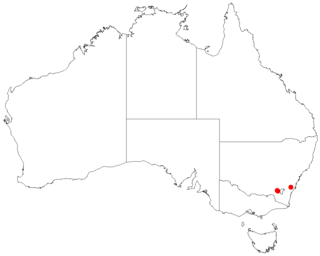
Prostanthera makinsonii is a species of flowering plant in the family Lamiaceae and is endemic to a restricted area of New South Wales. It is a spreading shrub with strongly aromatic, egg-shaped leaves and mostly glabrous purple flowers arranged in bunches of eight to twelve in upper leaf axils.
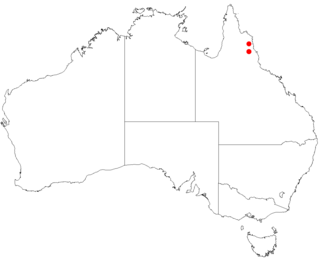
Prostanthera mulliganensis, commonly known as Mount Mulligan prostanthera, is a species of flowering plant that is endemic to Mount Mulligan in Queensland. It is a small shrub with hairy branchlets, oblong to egg-shaped leaves and mauve flowers with purple to dark mauve markings.

Prostanthera nanophylla is a species of flowering plant in the family Lamiaceae and is endemic to Western Australia. It is a small shrub with hairy branches, egg-shaped to elliptic or narrow oblong leaves and mauve or blue to white flowers with dull brown, maroon or purple spots.

Prostanthera oleoides is a species of flowering plant that is endemic to central Queensland. It is an open, erect shrub with four-sided branchlets, narrow elliptic, oblong or egg-shaped leaves with the narrower end towards the base, and mauve flowers with purple to dark mauve markings.
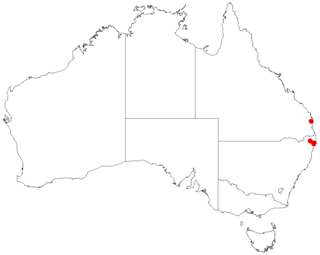
Prostanthera palustris, commonly known as swamp mint-bush, is a species of flowering plant in the family Lamiaceae and is endemic to a restricted area of New South Wales. It is a low, spreading, weak shrub with spatula-shaped leaves and pale mauve and white flowers with yellow spots in the petal tube.

Prostanthera sericea, commonly known as silky mintbush or walyuwalyu, is a species of flowering plant in the family Lamiaceae and is endemic to inland Australia. It is an erect shrub with hairy branches, cylindrical leaves and white flowers with mauve or purple streaks.
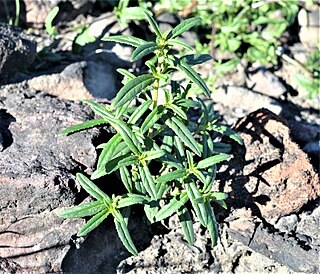
Prostanthera tallowa is a species of flowering plant in the family Lamiaceae and is endemic to the Kangaroo Valley area of New South Wales. It is an erect, aromatic shrub with narrow egg-shaped to linear leaves and mauve to light purple flowers with darker dots inside the petal tube.

Prostanthera tozerana is a species of flowering plant that is endemic to Mount Tozer in Queensland. It is a small, compact shrub with hairy branchlets, thick egg-shaped leaves with the narrower end towards the base, and pale purplish-mauve flowers.






















